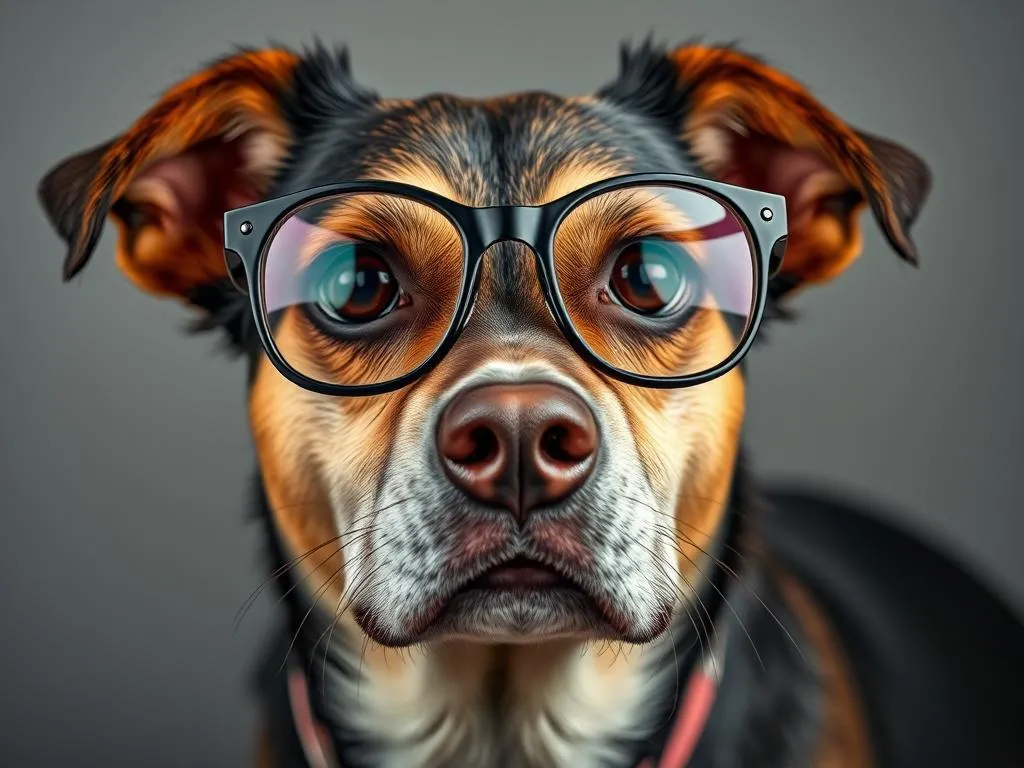
Introduction
Can dogs wear glasses? This question might seem unusual at first, but just like humans, dogs can experience vision problems that may require corrective eyewear. Understanding the importance of eye health in dogs is crucial for pet owners who want to ensure their furry companions lead happy, healthy lives. Common vision issues such as cataracts, glaucoma, and progressive retinal atrophy can affect a dog’s quality of life, making it essential to recognize the signs and seek timely veterinary advice.
In this article, we will explore the concept of dogs wearing glasses, the various reasons and benefits behind it, and how to ensure that your dog is fitted properly for their eyewear.
Understanding Canine Vision
Anatomy of the Dog’s Eye
To understand why some dogs might need glasses, it’s helpful to first look at the anatomy of their eyes. A dog’s eye comprises several parts, including the cornea, lens, retina, and optic nerve, all working together to process visual information.
One of the primary differences between canine and human vision is that dogs have a higher density of rod cells in their retinas, which allows them to see better in low-light conditions. However, they have fewer cone cells, which means they have a limited ability to perceive colors—primarily seeing shades of blue and yellow. This unique structure contributes to how dogs perceive the world around them, often described as a blend of colors and shapes rather than the vibrant spectrum humans see.
Common Vision Problems in Dogs
Just like humans, dogs can suffer from a range of vision problems. Some common conditions include:
- Cataracts: A clouding of the lens that can lead to blindness if left untreated.
- Glaucoma: Increased pressure in the eye, which can cause damage to the optic nerve.
- Progressive Retinal Atrophy (PRA): A genetic disorder leading to the gradual degeneration of the retina.
Signs that your dog may be experiencing vision problems include:
- Bumping into objects
- Hesitation in unfamiliar environments
- Changes in behavior, such as increased anxiety or reluctance to play
Regular eye check-ups with a veterinarian are vital for early detection and management of these conditions.
The Concept of Dogs Wearing Glasses
Reasons for Dogs to Wear Glasses
Can dogs wear glasses? Yes, and there are several reasons why they might need them.
- Protective Eyewear: Certain breeds with prominent eyes, such as Pugs or Bulldogs, can benefit from protective eyewear to shield their eyes from environmental hazards.
- Vision Impairments: Dogs with specific vision impairments may require corrective lenses to help them navigate their surroundings more effectively.
- Sunglasses for Dogs: Just like humans, dogs can benefit from sunglasses that offer UV protection and shield their eyes from wind and debris, making outdoor adventures safer and more enjoyable.
Types of Dog Glasses Available
When it comes to dog eyewear, there are various styles available to cater to different needs:
- Corrective Lenses: Designed to help dogs with vision impairments see more clearly.
- Sunglasses: Protect against UV rays and help prevent eye strain.
- Goggles: Often used for dogs that participate in outdoor activities, these can protect against wind, dust, and harmful debris.
Dog glasses are typically made from durable materials that can withstand wear and tear. When choosing the right type of glasses for your dog, consider their specific needs, lifestyle, and any recommendations from your veterinarian.
Fitting Glasses for Dogs
Measuring Your Dog for Glasses
Fitting glasses for your dog involves careful measurement to ensure a proper fit. Here’s a step-by-step guide to measuring your dog for glasses:
- Measure the Width of the Head: Use a soft measuring tape to find the widest part of your dog’s head, just above the eyes.
- Measure the Distance Between the Eyes: Measure the distance from the center of one eye to the other.
- Measure the Nose Length: Measure from the bridge of the nose to the tip.
- Consider the Ears: Make note of ear placement, as this can affect how the glasses fit.
Avoid common mistakes, such as measuring too loosely or forgetting to account for the dog’s comfort. A proper fit should allow the glasses to sit securely without causing discomfort.
Training Your Dog to Wear Glasses
Once you have the right pair of glasses, the next step is getting your dog accustomed to wearing them. Here are some tips for acclimating your dog to their new eyewear:
- Start Slow: Introduce the glasses gradually. Allow your dog to sniff and explore the glasses before attempting to put them on.
- Positive Reinforcement: Use treats and praise to create a positive association with the glasses. Reward your dog each time they wear them, even if just for a short duration.
- Monitor Comfort: Keep an eye on your dog’s behavior while they wear the glasses. If they seem uncomfortable or distressed, adjust the fit or try again later.
Training your dog to wear glasses might take time, but patience and consistency will help them accept their new accessory.
Safety and Care of Dog Glasses
Ensuring Safety While Wearing Glasses
While it might seem harmless for dogs to wear glasses, safety should always be a priority. Here are some considerations:
- Supervision: Always supervise your dog while they’re wearing glasses to prevent accidents or injuries.
- Check for Discomfort: Regularly check to ensure that the glasses fit well and are not causing any irritation or discomfort to your dog.
Maintenance and Cleaning of Dog Glasses
Proper care of your dog’s glasses will prolong their lifespan and ensure they remain effective. Here are some maintenance tips:
- Cleaning: Use a soft, non-abrasive cloth to clean the lenses regularly. Avoid harsh chemicals that could damage the material.
- Storage: Store the glasses in a cool, dry place when not in use to prevent scratches and damage.
- Signs of Wear: Keep an eye out for scratches, loose fittings, or other signs that the glasses may need replacement.
Consulting with a Veterinarian
When to Seek Professional Advice
If you notice any signs of vision problems in your dog, it’s crucial to seek professional advice. Indications that you should consult a veterinarian include:
- Sudden changes in behavior, such as reluctance to go outside or play.
- Difficulty navigating familiar environments.
- Persistent squinting or excessive tearing.
Veterinarians can conduct a thorough eye exam to determine the need for glasses or other treatments.
The Role of Veterinary Ophthalmologists
If your dog requires specialized care for their vision, a veterinary ophthalmologist can provide expert evaluation and tailored solutions. During a veterinary eye exam, you can expect:
- Comprehensive testing to assess your dog’s vision and overall eye health.
- Recommendations for treatment options, which may include the use of glasses, medications, or surgical interventions.
Veterinary specialists are equipped to handle complex issues related to canine vision and can work with you to ensure your dog receives the best possible care.
Conclusion
Addressing canine eye health is essential for maintaining your dog’s overall well-being. Glasses can play a vital role in improving the quality of life for dogs with vision impairments, offering them the opportunity to explore their surroundings safely. If you suspect your dog might benefit from wearing glasses, consulting with your veterinarian is the best course of action. With the right guidance, you can ensure that your beloved pet has the best vision and comfort possible.









